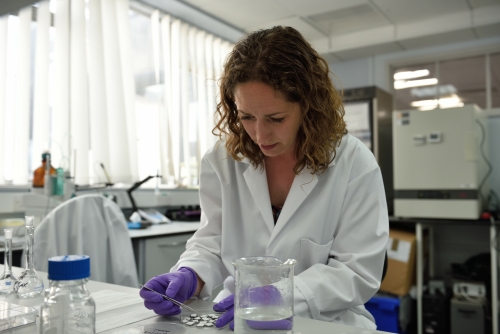Wound care material coatings with antimicrobial properties
An interdisciplinary team of researchers have developed a single-use application of sustained-release chlorehexidine to help combat umbilical cord infection in newborn babies. A new formulation of the drug addresses the issues surrounding its application in low-resource settings.
What is the problem?
99% of newborn deaths occur in low-resource settings. Umbilical cord infection, which can lead to sepsis and death, is a major contributor to this figure. Umbilical cord infection affects up to 25% of newborns in vulnerable populations. In some cases, infections in resource-poor settings are caused by antibiotic resistant strains of bacteria which makes treatment more difficult and increases the risk of mortality further.
To prevent umbilical cord infection, the WHO recommends applying chlorhexidine antiseptic gel to the umbilical cord stump daily for the first seven days of life. Although most new mothers will accept the application of the gel by a health assistant or midwife at birth, compliance during the days that follow is poor, meaning that the gel may only be applied once. The standard formulation disperses with friction, washing and sweat so daily application is essential to be effective at preventing infection.
A potential solution
Dr Michele Barbour (Bristol Dental School) has developed and patented a novel sustained release formulation of chlorhexidine (CHX). When in contact with a moist environment, the formulation releases CHX gradually over an extended period.
To circumvent the non-compliance problem and to protect newborns, Dr Barbour has brought together an interdisciplinary team to develop a single-use application of sustained-release CHX. Working with a formulation chemist and microbiologists, Dr Barbour’s team have developed both spray and emulsion cream formulations of CHX to deliver CHX in film-forming polymers. These polymers form a flexible, water-resistant and wear-resistant layer on the skin which has been shown to have antimicrobial efficacy that lasts at least a week.
Next steps
In country advisers are collaborating with the team to provide local insight and expertise for introducing its use in clinics in low-to-middle income countries.
Next steps also include research to further develop, validate and scale-up this technology. This will be achieved in conjunction with Dr Barbour's spin-out company, Pertinax Pharma Ltd, with support from an EPSRC-funded Knowledge Transfer Secondment Project.
Other applications for this technology to help combat infection and reduce the use of antimicrobials are also being explored. Through a BristolBridge networking event, Dr Barbour and Prof David Barrett (Bristol Vet School) met and they now have a joint PhD student working on developing the use of sustained-release CHX for the treatment of the ulcerative foot infection, digital dermatitis, in cattle which leads to lameness and poor milk yields. Current preventative measures involve group hoof disinfection in chemical footbaths which are often toxic and potentially damaging to the environment or even antibiotic solution footbaths which may drive the emergence of antibiotic resistance. Build-up of farmyard slurry in the footbaths renders them ineffective so prompt treatment of individual animals with sustained release CHX may help to overcome the current problems surrounding prevention and treatment.

Researchers involved
- Dr Michele Barbour (Oral Nanoscience research group, Bristol Dental School)
- Dr Jeroen van Duijneveldt (School of Chemistry)
- Dr Jim Spencer (School of Cellular and Molecular Medicine)
- Prof David Barrett (Bristol Veterinary School)
External collaborators
- Dr Rabaab Zahra (Quaid-i-Azam University, Islamabad, Pakistan)
Funding
- EPSRC BristolBridge
- EPSRC GCRF
- Elizabeth Blackwell Institute TRACK Award
- BBSRC SWBio DTP iCASE studentship
- The Industrial Strategy Challenge Fund via EPSRC
- Pertinax Pharma Ltd.
This research has benefited from collaboration with:
- US-based NGO PATH
Contact
Dr Michele Barbour
email: m.e.barbour@bristol.ac.uk
Tel: +44 (0)117 34 29573